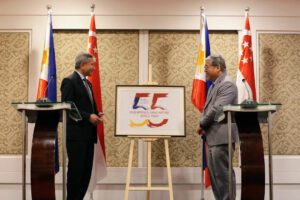The unkindest (oil) cut of all

The Organization of the Petroleum Exporting Countries and their allies, including Russia (called OPEC+), gathered on Oct. 5 for their first face-to-face meeting since the start of the COVID-19 pandemic in March 2020. They agreed to cut their oil production by two million barrels per day (bpd) in November, according to aljazeera.com/news (Oct. 6, 2022). OPEC+ controls more than 40% of global oil production.
The price of Brent crude, the international benchmark, rose 1.7%, reaching $93.29 a barrel. At the start of this year, Brent prices were close to $79 a barrel. It soared above $127 in March, two weeks after the Russian invasion of Ukraine — the highest in 14 years (Ibid.). Higher oil prices and a strong US dollar will make it more difficult for most countries buying their oil using dollars. The OPEC+ production cut will increase inflation further and raise the cost of living, especially for the emerging economies.
“That is the unkindest cut of all,” US President Joe Biden might have cried out, worried for the timing of the announcement so close to the US midterm elections. And the OPEC+ production cut would mean more income to the US enemy No. 1, Russia, in the Ukraine war. Yes, that would be a most apt quote from Shakespeare’s Julius Caesar (Act 3, Scene 2) — when his closest friend, Brutus, dealt the last fatal stab upon the betrayed king, Julius Caesar. For Saudi Arabia has been an ally of the US since before World War I, when America was the conquering Caesar of the world, in rivalry with Great Britain over the then yet un-awakened Eastern Europe and Middle East.
The British provided protection to Saudi territories from the Turks for many years before the unification of the Kingdom of Saudi Arabia (KSA) in 1928. But the Saudis owe it to the US that the very first oil well of commercial quantity was successfully drilled by Standard Oil of California in Dammam, near Dhahran in 1938. The joint enterprise, the Arabian American Oil Co. (Aramco) received exclusive rights to mine, produce, and export oil from the KSA, free of Saudi taxes and duties (Frontline, pbs.org).
That started the unchallenged recognition of Saudi Arabia as the world’s biggest oil supplier. But the agreement with Aramco was modified and thinned down over the years. In 1950, Saudi Arabia and Aramco agreed to a 50-50 profit-sharing arrangement, and a series of agreements between 1973 and 1980 resulted in the Saudis’ gaining full control of the company. In 1988, King Fahd issued a royal decree establishing the Saudi Arabian Oil Company, known as Saudi Aramco, to replace Aramco (Ibid.).
The souring of the Saudi “sweetheart deal” with Aramco coincides with the timeline of controversies and conflicts in KSA-US relations, in world political-economic developments through the years.
During World War II, KSA, a neutral state, was bombed by Italy, an Axis power, destroying a big oil installation in Dhahran and crippling Saudi Arabia’s oil production. Ibn Saud allowed the US Air Force to fly over the KSA when heading to Iran and the Soviet Union. Airfields were constructed and oil installations rebuilt. (Grayson, Benson Lee, 1982. Saudi – American Relations. University Press of America). US President Franklin D. Roosevelt with King Abdulaziz formalized the “Oil for Security” core concept of the US-Saudi Arabia relationship.
The Cold War of the 1950s and 1960s challenged the partnership between the US, which was anti-Soviet, and the KSA, whose King Saud was pro-Soviet along with his friend Egyptian president Gamal Abdel Nasser. Saud dismissed the US forces and replaced them with Egyptian forces. But when Nasser closed the Suez Canal in 1956, and the US successfully averted an Israeli, British, and French invasion to seize the canal, the repentant Saud allowed the American forces back into Saudi Arabia, replacing the Egyptian forces that replaced the US forces earlier.
And when Egypt attacked Saudi Arabia from bases in Yemen during the 1962 Yemeni revolution because of Saudi Arabia’s anti-revolution propaganda, US President John F. Kennedy immediately sent US warplanes to the war zone to stop the attack (Middle East Review of International Affairs. 2002. 6 (3): 77–102).
In November 1964, the new King Faisal participated in an oil embargo against the US and Europe in favor of the Arab position (which refused to recognize the state of Israel) during the Yom Kippur War, when Egypt and Syria attacked Israel. That embargo caused the big 1973-74 energy crisis in the US that affected the global economy. (The price of oil went up from $3 per barrel to $12 per barrel in three months!) The embargo was lifted in March 1974 after the US pressured Israel into negotiating with Syria over the Golan Heights (Ibid).
Iraq’s invasion of Kuwait in August 1990 led to the Gulf War, during which the security relationship between the US and Saudi Arabia was greatly strengthened. The US sent more than 500,000 ground troops and KSA, more than 100,000 troops to attack Iraqi troops in Kuwait in Operation Desert Storm, causing the Iraqis to retreat back to Iraq. And the US military presence was all the more entrenched in Saudi Arabia, which allowed the presence of US bases and sourced all its military equipment and training from the US.
But the US bases and presence of the US in the KSA was believed to be one of the reasons for the Sept. 11, 2001 suicide terrorist attacks on the World Trade Center in New York, killing nearly 3,000 people, by the militant Islamic extremist group Al Qaeda using highjacked American planes. Al Qaeda leader Osama bin Laden was known to be supported by the Taliban. The US and its allies in the “War on Terror” attacked Afghanistan, ousted the Taliban and established an interim government in December 2001. The Taliban regained control of Afghanistan in 2021.
In 2003, the US withdrew most of its troops from Saudi Arabia, with a token unit remaining for strategic presence. There was an arms-length relationship for some time, until the US was jarred by the killing of Jamal Khashoggi, an American journalist who disappeared and then was assassinated at the Saudi consulate in Istanbul. It was rumored that some high-ranking Saudi officials were involved in the killing (BBC News. Oct. 22, 2018).
The pivot of the KSA to Russia was evident when, in 2007, King Abdullah invited Russian President Vladimir Putin to Riyadh to award him the kingdom’s highest honor, the King Abdulaziz Medal. Russia and Saudi Arabia concluded a joint venture between Saudi Aramco and LUKOIL to develop new Saudi gas fields.
The chasm between the KSA and the US widened during the oil market crash of 2014, from the increased shale oil production in the United States, which, in turn, caused Saudi Arabian exports of oil to decrease by nearly 50%. Oil went from around $110 a barrel prior to the 2014 crash, to about $27 a barrel by the beginning of 2016, reported Al Jazeera (Dec. 4, 2018). “The shale industry has made America the world’s top producer of crude oil. When America’s sanctions on Iranian crude exports take effect, shale will help fill the gap,” the Economist said (Oct. 20, 2018).
On Aug. 9, 2020, Saudi Arabia announced that it would cut down its oil supply to the US for the third time in one year, in an attempt to suppress stockpiles in the global oil market to rebalance demand and supply. (OEC Datawheel. Nov. 19, 2018). However, experts claim that the strategy worked in 2017 when the demand for oil was high (but) may bear challenges and risks at present, due to the impact of the ongoing coronavirus crisis on oil demand.
The Biden administration already plans to sell at least 165 million barrels of crude through November from US reserves to combat rising prices. Biden could order more oil releases and try to drive the price of oil down further (bloomberg.com, Oct. 14, 2022).
The US Congress is mulling the stoppage of all arms sales to Saudi Arabia. The Saudi military’s armaments are 75% composed of US equipment, including high-end systems such as fighter jets. That equipment depends on US contractor support and spare parts, offering an obvious point of leverage for Washington (Ibid.).
The leveraging between traditional political and economic allies Saudi Arabia and the US over this OPEC+ oil production cut shows the true picture of the real struggle for survival in our depleted world. New dominant players are emerging, and the old powers are waning. “The episode was also a reminder of just how much the US relationship to the Middle East has changed…Gulf nations have shown an increased willingness to challenge or defy the US as they seek out other partners such as China,” notes bloomberg.com (Oct. 14, 2022). The Wall Street Journal carried this headline earlier this year: “Saudi Arabia Considers Accepting Yuan Instead of Dollars for Chinese Oil Sales” (wsj.com, March 15, 2022).
It is to the developing world that “the unkindest cut of all” is dealt — in the anxieties for their unsure future.
Amelia H. C. Ylagan is a doctor of Business Administration from the University of the Philippines.




